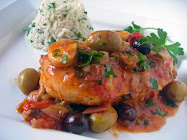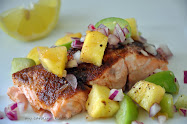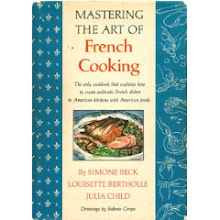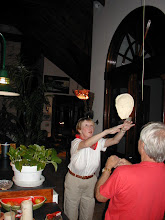I thought it might be fun to have a throwdown with mussels – Thai coconut basil mussels vs. French Moules a la Mariniere, or mussels in white wine. Mussels in white wine are a specialty of my husband Meakin and the Thai coconut basil mussels recipe is one we recently tried from Cooking Light.
Both recipes are very easy and can be put together in 30 minutes. I’m always surprised when I hear people say they think mussels are difficult to prepare and it’s just not true. Cultivated mussels can be found in most supermarkets today and no longer have beards so they don’t have to be cleaned as they once did.
In the Thai coconut mussel dish we added lemongrass for a bit more flavor, but if you can’t find lemongrass, don’t worry. It’s not absolutely necessary because the fish sauce adds a nice layer of flavor and the lime juice perks up the sauce. I find that if fresh basil is heated it turns black, so we waited until the last minute to add it. This is a very light and colorful dish and if you want to make it a bit more substantial, you can serve it with scallion rice.
Moules a la Mariniere, or mussels steamed in white wine, is a French classic bistro dish that you may remember from our archives and we serve it often. Meakin steams the mussels in a wine and chicken broth mixture, finishes them with tomatoes, cream and a dash of Pernod, an anise flavored French liquor, and dinner is served before you know it. We like to keep a bottle of Pernod on hand so we can use a splash of its citrusy anise flavor in seafood to give it a Mediterranean twist and a taste of Provence. In the south of France Pernod is sipped as an aperitif called pastis. Typically waiters bring small glasses of Pernod on a tray to your table with a pitcher of cold water for diluting the strong green liqueur, making it turn cloudy and yellow.
 |
| Pastis |
Coconut and Basil Steamed Mussels
Adapted from Cooking Light – serves 2
Printable recipe
¼ cup minced shallots
2 teaspoons minced garlic
1 cup light coconut milk
2/3 cup water
1/3 cup low sodium, fat free chicken broth
About a 3” piece of fresh lemon grass, 1" of the root end crushed with a knife, optional
1 tablespoon fresh lime juice
1 teaspoon dark brown sugar
1 teaspoon fish sauce
½ to 1 teaspoon Sriracha chili sauce
24 mussels, about 1 pound, scrubbed and de-bearded if necessary
Slivered fresh basil leaves
Heat a Dutch oven over medium heat and add oil to pan, swirling to coat. Add shallots and garlic to pan and cook 2 minutes or until tender, stirring frequently to make sure neither burn. Shake the can of coconut milk well, then stir in along with the milk, water, broth, lemon grass, lime juice, sugar, fish sauce and Sriracha and bring to a boil. Add the mussels to the pan, cover and cook 5 minutes or until shells open.
Remove mussels from the pan with a slotted spoon and reserve the broth mixture. Remove lemongrass and discard. When mussels are cool enough to handle, remove most of them from their shells and save a few with shells for presentation. Throw away any mussels that did not open. Bring broth to a boil and cook for 5 minutes. Divide the mussels between 2 serving bowls. Pour 1 cup of hot broth over each serving. Sprinkle with slivered fresh basil and serve right away. Nice with crusty bread for dipping or serve with scallion rice, recipe below.
Scallion rice
Combine 1 cup water, 1/2 cup jasmine rice, 1 teaspoon butter, 1/4 teaspoon kosher salt, and 1 thinly sliced green onion in a small saucepan; bring to a boil. Cover, reduce heat, and simmer 15 minutes; remove from heat. Let stand 5 minutes. Fluff with a fork.
Mussels in white wine a la Chez Meakin - Moules a la Mariniere
By Meakin Hoffer from My Carolina Kitchen - serves 4
Printable recipe
3 pounds of small cultivated mussels, scrubbed and debearded if necessary
1 leek
2 cloves of garlic, finely chopped
2 tablespoons extra virgin olive oil
2 cups chicken broth (we like the low sodium & fat free variety)
1 cup dry white wine
1 - 14.5oz can whole tomatoes
½ cup of half & half or cream
2 capfuls of Pernod (optional)
Pinch of cayenne pepper
Kosher salt and freshly ground black pepper to taste
4 tablespoons chopped fresh Italian parsley
Rinse the mussels in water, scrub and de-bead if necessary. Cut the dark green leaves off of the top of the leek and discard them. You will be left with the light green leaves and white end. Cut the roots off of the white end and discard it also. Cut the remainder of the leek in half lengthwise, rinse well under running water to remove any dirt, and shake dry. Cut each half of the leek in half again and thinly slice.
Add the olive oil to a large non-aluminum stock pot and set the heat to medium. Sauté the leek and garlic in the olive oil for 3 to 5 minutes to soften, taking care not to brown. Add the mussels in their shells, chicken broth and wine to the stock pot and stir well. Raise the heat to medium high. Cover and cook for 8 to 10 minutes, or until the mussels open. Discard any mussels that do not open.
Remove the stock pot from the heat and allow the mixture to cool. When it is sufficiently cool, carefully remove the mussels from the liquid and pick them from their shells, leaving a few in their shells for a garnish. Discard the remaining shells.
Add the mussels back to the liquid in the stockpot along with a can of whole tomatoes which you have gently crushed with your hands along with their tomato liquid. Stir, then bring the mixture to a boil, immediately turn the heat down to medium low and let it simmer about 10 minutes. Add the half & half, Pernod if using, a good pinch of cayenne pepper and salt and pepper to taste. Let it heat through. Serve immediately in bowls with chopped fresh parsley for garnish. Accompany with slices of a crusty French baguette for dipping.
* * *
This will be shared with Foodie Friday at Rattlebridge Farm, Miz Helen’s Country Kitchen Full Plate Thursday, Foodie Friday at Simple Recipes, and Comforts of Home Tasty Tuesday.
Thank you for your kind words of encouragement with regard to my physical therapy. I've had therapy several times in the past and I've just started this round. It has been more painful than I expected and I hope to have that portion of the treatment corrected by the time you read this. Thank you again for caring. It means so much to me.
Have a great weekend everyone.















































